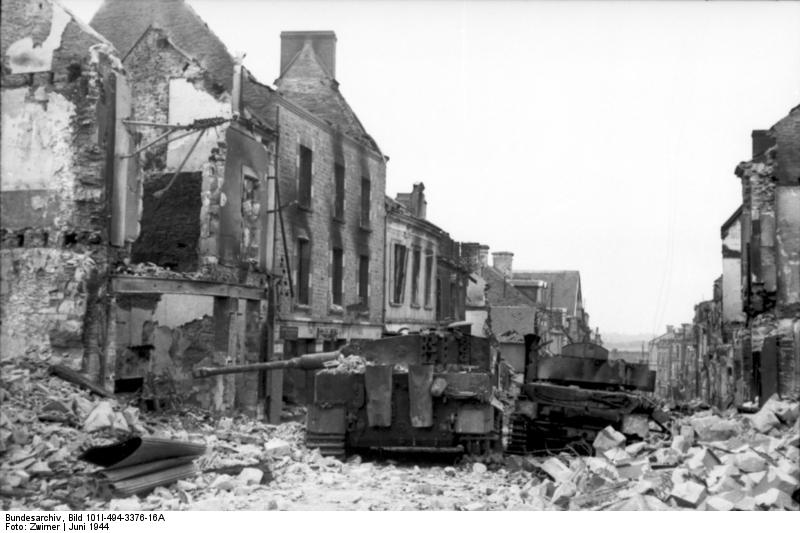
| Caption | Wrecks of German Tiger I and Panzer IV tanks, Villers-Bocage, France, Jun 1944, photo 4 of 4 ww2dbase | |||||||||||
| Photographer | Zwirner | |||||||||||
| Source | ww2dbaseGerman Federal Archives | |||||||||||
| Identification Code | Bild 101I-494-3376-16A | |||||||||||
| More on... |
| |||||||||||
| Photo Size | 800 x 533 pixels | |||||||||||
| Photos in Series | See all 3 photos in this series | |||||||||||
| Photos on Same Day | 12 Jun 1944 | |||||||||||
| Added By | C. Peter Chen | |||||||||||
| Licensing | Creative Commons Attribution ShareAlike 3.0 Germany License (CC BY-SA 3.0 DE).
See Bild 101I-494-3376-16A on Wikimedia Commons According to the German Federal Archive (Bundesarchiv), as of 21 Jul 2010, photographs can be reproduced with if these preconditions are met: - add the signature of the pictures and - of name of the originator, i.e. the photographer. ... You also can use fotos from the Federal Archives for free on Wikimedia Commons http://commons.wikimedia.org/wiki/Commons:Bundesarchiv Please contact us regarding any inaccuracies with the above information. Thank you. |
Did you enjoy this photograph or find this photograph helpful? If so, please consider supporting us on Patreon. Even $1 per month will go a long way! Thank you. Share this photograph with your friends: Stay updated with WW2DB: |
Visitor Submitted Comments
All visitor submitted comments are opinions of those making the submissions and do not reflect views of WW2DB.
Search WW2DB
News
- » Wreck of USS Edsall Found (14 Nov 2024)
- » Autumn 2024 Fundraiser (7 Nov 2024)
- » Nobel Peace Prize for the Atomic Bomb Survivors Organization (11 Oct 2024)
- » Wreck of USS Stewart/DD-224 Found (2 Oct 2024)
- » See all news
Random Photograph
Current Site Statistics
- » 1,150 biographies
- » 337 events
- » 43,917 timeline entries
- » 1,241 ships
- » 350 aircraft models
- » 207 vehicle models
- » 374 weapon models
- » 123 historical documents
- » 260 facilities
- » 470 book reviews
- » 28,542 photos
- » 432 maps
Famous WW2 Quote
"Since peace is now beyond hope, we can but fight to the end."Chiang Kaishek, 31 Jul 1937
Support Us
Please consider supporting us on Patreon. Even $1 a month will go a long way. Thank you!
Or, please support us by purchasing some WW2DB merchandise at TeeSpring, Thank you!
11 Sep 2011 11:11:12 AM
Another view for photograph one, taken from the back. Tiger on the left, and Panzer Mk IV on the right. Urban combat is a tankers no, no. Tanks need room to operate, and flex its muscles.
TANKERS WORST NIGHTMARE: STREET FIGHTING
Tanks and other armored fighting vehicles, need infantry support on the ground to provide security. Tanks fighting in urban areas create many problems, firing the main gun leaves smoke and flame, dirt and masonary
dust add to the smoke cloud, dust also obscure the target that could last a few mimutes.
Enemy infantry armed with anti-tank weapons can advance through the rubble run between building and alleys and narrow streets.
Defending troops could use satchel charges under cover of dust and smoke to disable the tank. Overpressure from firing its main gun
creates problems for the tanks infantry
support. Closed in areas also create problems in operating the tank rotating its turret a full 360 degrees.
These are my theories, but if you want to slow down tanks, get them into the city or a
village narrow street and alleys.
During the Hungarian Revolution of 1956 the Hungarians placed upside frying pans, on the streets, so they looked like mines.
The tanks stopped and came under attack from roof tops,narrow streets and alleys.